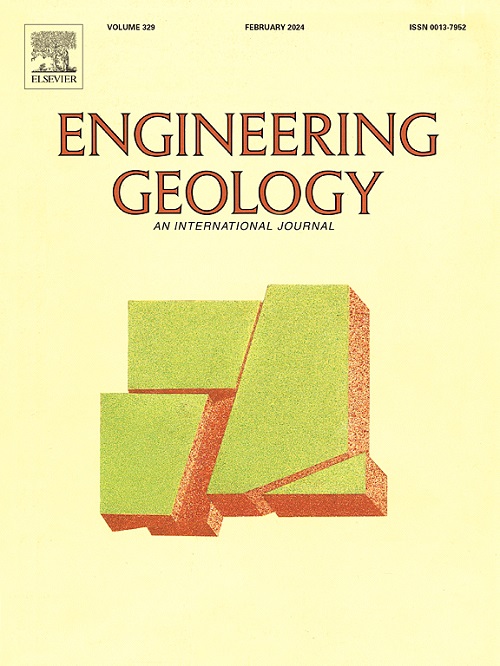长江下游河流阶地液化诱发的横向扩展特征
IF 6.9
1区 工程技术
Q1 ENGINEERING, GEOLOGICAL
引用次数: 0
摘要
河流阶地在液化作用下的横向扩展对长江下游的自然环境和人工环境造成了巨大的物理破坏。本文采用Abaqus/Explicit程序,结合可液化沉积物的空间变异性、液化后阶段的起液化和循环迁移性以及大范围变形引起的几何非线性等主要特征,提出了一种用于表征长江宽流域几公里尺度上大尺度横向扩展行为的综合非线性场地响应分析方法。特别地,数值模型中的大变形行为在单元级采用基于塑性的模型,在模型网格级采用任意拉格朗日-欧拉(ALE)方法进行模拟。研究了影响横向扩展行为的关键因素,包括地面运动特征、河流阶地的坡度角和场地条件的空间变异性。数值结果表明,河流阶地横向扩展具有明显的空间变异特征,其触发点为微倾斜斜坡。在侧向位移时程曲线上,可以识别出横向扩展的3代阶段,分别为摆动阶段、滑移阶段和蠕变阶段。最后,将所提出的模型性能与常用的经验公式进行对比分析,并解释两者之间的差异,为宽河谷河流阶地液化诱发侧向扩展的机理提供了新的认识。本文章由计算机程序翻译,如有差异,请以英文原文为准。
Liquefaction-induced lateral spreading characteristics of the fluvial terraces at the lower reaches of Yangtze River
The liquefaction-induced lateral spreading of the fluvial terraces can cause tremendous physical damage to the natural and built environments in the lower reaches of Yangtze River. This paper presents an integrated nonlinear site response analyses method to characterize the large-scale lateral spreading behavior in the wide river valley of Yangtze River at the scale of several kilometers in the Abaqus/Explicit code, incorporating the main features such as the spatial variability of liquefiable deposit, the liquefaction initiation and cyclic mobility at the post liquefaction stage and the geometric nonlinearity induced by the extensively large deformation. In particular, the large-deformation behavior in the numerical model is simulated by the plasticity-based model at the element level and the arbitrary Lagrange–Euler (ALE) method at the model mesh level. The key factors influencing lateral spreading behavior are investigated, involving the ground motion characteristics, the slope angle of fluvial terraces, and the spatial variability of site condition. The numerical results indicate significant spatial variation characteristics of the lateral spreading of the fluvial terraces, triggered in the slightly inclined slope. Three generation stages of lateral spreading could be identified in the time-history curve of lateral displacement, i.e. swing stage, slip stage and creep stage, respectively. Finally, the model performance of the proposed modelling method is evaluated against the widely-used empirical formula, and the difference between each other is interpreted, which provides new insights into the mechanism of liquefaction-induced lateral spreading of the fluvial terraces in the wide river valley.
求助全文
通过发布文献求助,成功后即可免费获取论文全文。
去求助
来源期刊

Engineering Geology
地学-地球科学综合
CiteScore
13.70
自引率
12.20%
发文量
327
审稿时长
5.6 months
期刊介绍:
Engineering Geology, an international interdisciplinary journal, serves as a bridge between earth sciences and engineering, focusing on geological and geotechnical engineering. It welcomes studies with relevance to engineering, environmental concerns, and safety, catering to engineering geologists with backgrounds in geology or civil/mining engineering. Topics include applied geomorphology, structural geology, geophysics, geochemistry, environmental geology, hydrogeology, land use planning, natural hazards, remote sensing, soil and rock mechanics, and applied geotechnical engineering. The journal provides a platform for research at the intersection of geology and engineering disciplines.
 求助内容:
求助内容: 应助结果提醒方式:
应助结果提醒方式:


